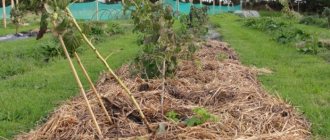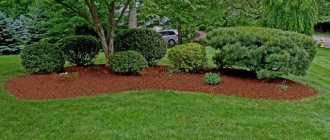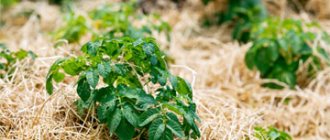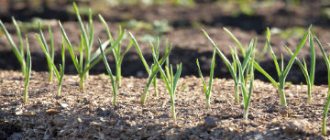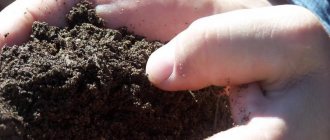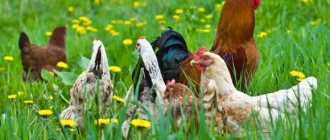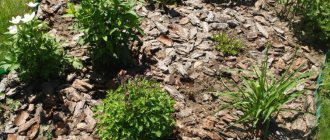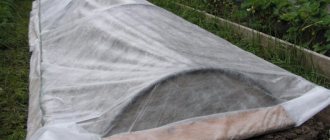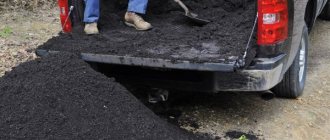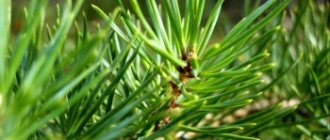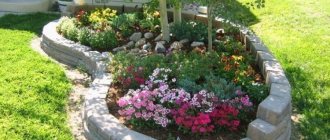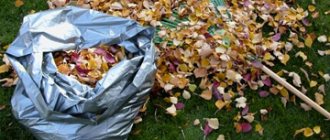Loading…
Loading…
To create a high-quality green blanket on the territory of a country house, you need to work hard. However, many summer residents use a modern lightweight method - mulching the lawn with a lawn mower, which helps save physical effort. What is the principle of this technique? What results does this approach bring? Answering questions will help you stay informed about new technologies and keep up with progress.
Mulching a lawn with a lawn mower: general information and advantages
Some people think that caring for a green lawn includes only 2 basic procedures: watering and mowing the grass.
Yet this is far from the case. Over time, the soil surface becomes hard and many irregularities appear on it. Most often this happens for the following reasons:
- frequent watering;
- climatic conditions;
- mechanical damage.
As a result, the soil needs fertilizing in order for the plants on it to look healthy. Otherwise, the grass will grow worse, and over time it will lose its color saturation. Mulching your lawn with a lawn mower is an ideal way to keep your lawn in tip-top condition. But for this you need to purchase a special unit.
A regular lawn mower has a large grass catcher where the cut greens fall. A special plug is installed in a mower designed for mulching. Thanks to it, the grass returns to the knives, turning into small crumbs. As the unit moves, it is evenly destroyed throughout the entire green lawn. It turns out that mulching the lawn with a lawn mower occurs mechanically. After all, the mowed grass immediately turns into organic fertilizer, which goes directly to the soil.
This mulching method promotes plant resistance to the following factors:
- summer heat;
- winter cold;
- excessive humidity;
- dry periods;
- various diseases;
- appearance of weeds.
The first result of mulching with grass from a lawn mower appears after 10 days. Plants acquire a rich emerald color and grow much faster.
This technology includes several main advantages:
- saving money and labor costs;
- speed of work (no need to stop periodically to unload the container);
- obtaining high-quality natural fertilizer;
- protection of the top layer of soil from drying out.
Some gardeners believe that the resulting green mixture clogs the lawn and spoils its aesthetic appearance. However, the fine chaff lies on the ground in an even layer, falling into the space between the stems of the plants. To understand the principle of operation of such an agronomic technique, it is advisable to know what it is - lawn mulching. Let's consider its main nuances.
When purchasing a lawn mower, you need to pay attention to its power. Otherwise, the quality of chopping green mass will suffer.
What to mulch with?
Freshly cut grass, hay, straw, sawdust, pine needles, leaf litter and even egg cells are most often used as mulch in beds ; The row spacing is mulched with cardboard or newspaper, chopped branches. These are organic components that will later turn into humus - the top fertile layer. Inorganic mulching materials include black film, roofing felt, black spunbond non-woven material (lutrasil, agrofibre, agrospan).
I will dwell in more detail on some of the materials that I use in my garden.
Mulching with freshly cut grass
Freshly cut grass is a great way to mulch garden beds! The grass can be mowed with a scythe, or simply collected by hand, weeding the beds. But it is best to use a lawn mower that shreds the grass clippings well. This mulch quickly rots, enriching the soil; earthworms love to carry it around. It is recommended to slightly dry (wither) grass freshly cut with a lawn mower before use so that it does not rot. I used to spread such grass on a large piece of banner, and after a couple of hours I used it for mulching. Now I’ve stopped bothering so much, I mulch directly from under the lawn mower, and have not yet discovered the negative consequences of such mulching.
Seedlings mulched with freshly cut grass
By the way, I noticed another positive side of mulching with freshly cut grass: when you lay out a thick layer (10-15 cm) of such grass between the rows, the grass warms up quite strongly and warms the soil. And if after sowing the bed was still covered with white spunbond, then it creates its own warm microclimate, which young seedlings really like! And, of course, a thick layer of grass between the rows inhibits the growth of weeds, which gives a good head start to the plants we planted!
You must keep in mind that you can mow the grass for mulching before the seeds ripen on it, otherwise you will not protect your beds from weeds, but, on the contrary, will sow them. I chose an exception to this rule for myself - dandelions. I feel so sorry for mowing them down during flowering, because they are so beautiful! I mow them when they begin to bloom, I know that I am seeding my beds with dandelions, but I even like it!
First of all, dandelion is easy to weed. Secondly, it itself is so powerful that it kills other weeds. Thirdly, dandelion is a biodynamic plant. Getting into the soil in any form (cut mulch or infusion), dandelion improves the biochemical processes in it. Fourthly, you can eat dandelions: make salads from the leaves, and make jam from the flowers! In general, dandelions are my allies, so I treat them with special respect! Well, you decide for yourself - do you need such an ally in the garden? If not, then you should mow the dandelions before flowering or, conversely, wait until they bloom and drop their seeds, and then mow them for mulch.
“Mulching Farmer's Kit”: Makita 1300 W lawn mower and Winky wheelbarrow. In the background there is waist-deep grass. I don’t know whether the lawn mower manufacturers planned that their little one would “bite into” such thickets, but Makita has been coping flawlessly for the fifth year now! I love this assistant of mine - powerful, but light, and inexpensive! She makes excellent mulch, not too fine. In general, I recommend it, especially to women!
Freshly cut grass used as mulch, as you already understand, has many advantages, but there are also (small) disadvantages. I include the fact that for some reason there is always not enough grass, even when you have a hectare of land. What can we say about the owners of six acres - they will have to look for land for mowing. Perennial weeds are also making their way through the grass, albeit belatedly, and they have to be weeded out. Well, you need to apply such mulching every 3-4 weeks, because the grass decomposes and is pulled away by soil inhabitants, and the mulch layer quickly becomes thinner. I completely mow the area and mulch all the beds 3-4 times a season, this takes 2 days a month. But the rest of the time you don’t have to go near the beds, except for the harvest!
Hay as mulch
Hay is usually mowed and dried grass. Hay is difficult to chop, so it is convenient to use it mainly for preparing new beds (cover the soil with a thick layer (20-30 cm) and leave until next spring) or for mulching potatoes (cover the emerging sprouts with a layer of 10-20 cm). It is inconvenient to use hay in beds, especially narrow ones. Hay also rots, but not as quickly as freshly cut grass; you can mulch with hay 1-2 times per season.
Tomatoes mulched with hay
Among the disadvantages, again, it can be noted that there is always not enough hay. We once tried to buy hay in rolls from a neighboring farm. As a result, the hay carried a lot of weed seeds, and even the “terrible and dangerous” hogweed. And, of course, the inhabitants of the soil prefer fresh grass to dry grass, and that’s understandable!
Mulch with straw
Straw is the stems of grain crops. It is usually difficult to grow enough wheat, oats or rye on a plot to supply the garden with straw for mulching, so straw is most often purchased in bales. Unlike hay, straw usually does not contain weed seeds. It is quite fragile, you can crush it by hand and mulch the beds.
But it is better, of course, to line the areas of land with straw where it is planned to make beds next year. Or line the compost beds with a thick layer and the soil between them, and then spread the straw and plant the seedlings.
Garden strawberries love straw mulch!
Using a thick layer of straw, you can get rid of, for example, an old strawberry plantation - do not pull out the bushes, but cover the top with straw. In a year there will be no trace left of the plantation. They also recommend mulching strawberries with straw, they love it!
In terms of nutritional value, straw is inferior to hay. And getting it, at least here, is quite problematic. Therefore, I used straw in my garden only once, and then switched to grass.
Artificial non-woven materials for mulching
Spunbond (lutrasil, agrofibre, agrospan) is a non-woven covering material, usually black. The density varies, I use 60 g/sq.m. For plants that do not like overheating, two-color spunbond is produced - black on the inside (the side adjacent to the ground) and light (white or yellow) on the outside. The black inner layer prevents weeds from growing, and the light outer layer reflects light onto the plants without heating up. I use this spunbond, for example, for cabbage.
In the foreground, a bed with cabbage seedlings planted is mulched with black and yellow spunbond (unfortunately, all the colored covering materials that I used quickly fade. Here, too, the yellow side has turned into almost white). In the background, the bed is mulched with black spunbond.
Spunbond is a “breathable” material, it allows air and water to pass through; if necessary, you need to water the garden bed directly over it. If you look closely at the spunbond, you will notice that one side is smooth, glossy, and the other is linty, fluffy. If it is necessary for water to be absorbed into the mulched soil during rain (and this is exactly what we need in our weather conditions), the spunbond is laid on the soil with the fluffy side up. The fibers retain droplets of moisture, which, as if through small funnels (this is the structure of the fiber), enter the soil. The inner glossy side, on the contrary, prevents moisture from leaving the soil and evaporation.
Weeds do not grow under the black dense spunbond; they do not have enough light. BUT! When you make slits in the spunbond to plant seedlings, the weeds have enough light from these small “windows” to begin their growth. Usually weeds have to be pulled out of the slits. If the planted plants are powerful and spreading, such as zucchini, pumpkins, they press the fiber and weeds underneath with the weight of their lashes, and the foliage eventually covers the holes through which the plant was planted, so the weeds eventually die.
But when you plant, for example, young large-fruited garden strawberries, the bushes do not have time to grow in the first year, and in order to cut off the weeds, when planting the seedlings, when planting the seedlings, I mulch it additionally with hay (right under the spunbond), and I fasten the material itself at the cut site using ordinary office stapler. If this is not done, then the weeds will even have enough strength to lift the spunbond and pull the staples that fastened the material out of the ground.
The service life of spunbond is 3-5 years, then it begins to deteriorate. It is convenient to cover compost beds with spunbond, since they initially contain enough food for plants for 2-3 years. Then the material can be removed, the bed can be sowed with root crops (very good, loose soil under the spunbond is obtained, root crops love this) and organic materials can be used as mulch.
Large-fruited garden strawberries on black spunbond feel great!
As I already wrote, I grow strawberries on spunbond. Very convenient, minimal maintenance. In the spring, I go through the garden bed with a fan rake, remove last year’s dried leaves, and that’s it.
The downside is that ants love to live under the spunbond. And, of course, the material costs money, although I decided for myself that my time and effort are more valuable!
A cheap way to create an elite lawn
According to some sources, mulching was invented by English gardeners. When the use of watering hoses was prohibited, they began to cover the green lawns with chopped vegetation.
Today this is called lawn mulching. It includes several procedures:
- regular grass mowing;
- cleaning dried plants;
- processing of raw materials;
- returning mulch to the soil surface.
Thanks to this, the temperature balance on the lawn is regulated during the cold season. Moisture is retained during hot summers. Fertilizing the soil with useful substances. Protecting the area from weeds.
Having carefully examined the root zone of plants, you can see how it successfully develops and bushes. In addition, the turf layer becomes much thicker and denser. Indeed, at all times, high-quality fertile soil was the key to the prosperity of green spaces.
In regions where harsh winters prevail, it is advisable to create a thick layer of turf on lawns.
Why mulch the soil in a greenhouse?
Plants in a greenhouse do not fare as well as one might think. They suffer from lack of moisture, lack of nutrients, heat and temperature changes.
Those who mulch the soil in a greenhouse note that the seedlings get sick less and grow better. In addition, weed growth is dramatically reduced. For mulching in a greenhouse, you need to choose organic mulch, in decreasing order of benefit:
- humus;
- sawdust spilled with urea;
- straw
You can cover the soil in the greenhouse with film or spunbond.
Operating principle of the new generation unit
Thanks to modern technologies, a lawn mower with mulching was created, which was liked by many owners of country houses. The principle of its operation is quite simple. 2 metal blades are equipped with sharp knives. They are located opposite each other. When energy is supplied, movement begins, thanks to which the cut grass turns into fine chaff.
Different models of mowers deal with grass differently:
- throw plants back or in different directions;
- collect raw materials in special containers;
- Immediately grind the greens into powder and scatter them around the area.
Of course, the third option is the best, since mulching occurs while the unit is moving. Thus, the soil receives an abundance of organic mixture, which microorganisms transform into high-quality fertilizer. This mulch is equivalent to humus, since it contains many useful substances. Therefore, summer residents do not buy additional fertilizers, saving their material resources.
Since both gas and electric mowers are available in the market, you should choose wisely. Each of them has its pros and cons.
Petrol mowers with mulching
The best assistant for caring for a large lawn will be a gasoline lawn mower with a mulching function.
Its main advantage over the electric version is that there is no need to unwind a long cable and constantly ensure that it does not get under wheels or knives. With a gas mower, you can cut tall and wet grass without the risk of electric shock.
Among all lawn mowers, gasoline versions are distinguished by high power and performance. With their help you can cut tough grass and coarse weeds.
When choosing, it is better to choose self-propelled lawn mowers. In them, the energy generated by the engine is directed not only to the rotation of the blades with knives, but also partially to the wheels. Therefore, when working with such a mechanism, you will not need a lot of physical effort; you will only need to set the direction of movement.
Self-propelled petrol mowers are:
- more maneuverable, they are suitable for processing a flat lawn on which there are many trees, shrubs, flower beds, and garden paths;
- for uneven areas, they can be used to treat lawns that are not too level and have a slope.
If you have a small lawn at your summer cottage with some obstacles (alpine slide, pond, fountain, benches), then it is better to choose a front-wheel drive lawn mower. Rear-wheel drive vehicles are suitable for cultivating sloping areas. The second option is usually more powerful due to the fact that you have to overcome inclined areas, but it also consumes much more fuel.
Basic rules for mulching a lawn
For a long time, gardeners have tried to remove all weeds from their garden beds. However, practice has shown that after processing they can bring a lot of benefits. Is it possible to mulch lawns with freshly cut grass or does it need to be dried first?
The use of modern lawn mowers shows that this is a completely acceptable way to fertilize a green lawn. But for this you need to adhere to the basic rules:
- mulching is carried out on short grass;
- during processing, approximately a third of the plants are cut off;
- the unit must operate at maximum power;
- Only sufficiently sharp knives are acceptable;
- Periodically clean the decks from plant debris.
Experienced gardeners have noticed that lawn mowers can only be used on a flat surface. Otherwise, the unit may break.
If there is tall grass growing on lawns, it is cut off gradually using a stepwise method. In order for mulching to be of high quality, it is advisable to periodically change the movement around the area. As a result, the vegetation is evenly distributed throughout the lawn.
As you can see, the process of mulching is quite a pleasant experience. The main thing is to purchase a suitable unit and act in accordance with the basic rules.
How to cook it yourself
In order for such mulch to bring maximum benefit to plants, it must be prepared correctly:
- Immediately after mowing, we rake up fresh grass and mulch the beds and trees with it.
- or we put it in the composter to bring it to the required state. We are waiting for it to light up.
The method of using cut greenery depends on the purpose of mulching:
- fresh material is perfect for protecting against moisture evaporation (especially important in southern regions), hypothermia or overheating, and prevents the growth of weeds;
- if you want to improve the structure of the soil and increase its fertility, you need to use partially burnt grass;
- on poor soils lacking organic matter and minerals, use composted greens in combination with rotted manure or humus.
If you use grass that has caught fire, be sure to place cut plastic bottles around the plants. They will protect the trunks from the touch of mulch.
What does mulching do for a plant?
Issues of soil covering have been carried out for several decades at the Institute of Plant Protection and its branches. As a result of many years of research, it was established:
- surface covering of the soil around the root reduces the amount of watering in the warm season, the soil evaporates less moisture;
- mulch prevents the soil from overheating in hot weather, protects during cold spells, and smoothes out the effects of air temperature changes;
- the wind does not blow away particles of the soil layer, erosion stops completely;
- covering materials do not allow nitrogen to evaporate after its application;
- the organic matter of mulching elements is used in the nutrition of coelenterate animals, assimilating rotted remains, they fertilize the soil and improve its composition;
- the development of weeds is prevented. The need for regular weeding is reduced;
- productivity increases, as the root part receives enough air and moisture;
- It is easier for a vegetable grower to adjust the pH of the soil by adding acidic or alkaline fertilizers. Under a layer of mulch, the effect of using fertilizers is much higher.
Interesting data is provided by Professor Dmitry Ivanovich Netkachev, who deals with increasing the productivity of traditional garden crops in Central Russia. He established interesting facts about vegetables over recent years of observation.
Extract from the research of Professor D.I. Netkachev (effect of mulching on yield):
| Type of vegetables | Year of observation | Productivity per hundred square meters, kg/(100 m2) | |
| Control group (traditional cultivation) | Experimental group (mulching was used) | ||
| Garlic | 2010 | 135 | 208 |
| Potatoes (Udacha variety) | 2010 | 454 | 658 |
| Potatoes (Lugovskoy variety) | 2010 | 316 | 576 |
| Potatoes (Nevsky variety) | 2010 | 322 | 606 |
| Tomatoes (Eldorado variety) | 2011 | 560* | 874* |
| Tomatoes (Golden Stream variety) | 2011 | 488* | 756* |
| Tomatoes (Vityaz variety) | 2010 | 512** | 724** |
| Tomatoes (Pink Honey) | 2010 | 432** | 535** |
| Tomatoes (Labrador variety) | 2016 | 488* | 603* |
| Tomatoes (variety Pickling miracle) | 2016 | 376** | 465** |
| Tomatoes (hybrid Katyusha F1) | 2016 | 463* | 621* |
| Pepper (Lastochka variety) | 2010 | 265** | 340** |
| Pepper (Big Mama variety) | 2011 | 243** | 312** |
| Pepper (Kupets variety) | 2014 | 274* | 401* |
| Pepper (Atlant variety) | 2016 | 270* | 388* |
| Eggplant (Vakula variety) | 2012 | 189** | 256** |
| Eggplant (Black Beauty variety) | 2011 | 264* | 341* |
| Eggplant (Albatross variety) | 2016 | 230* | 410* |
| * Greenhouse cultivation, recalculation of output per 100 m2 ** Growing in open ground, greenhouse made of non-woven material, recalculation of output per 100 m2 | |||
Data shows that the use of mulch actually increases the yield of vegetables when grown in greenhouses and outdoors.
What grass is suitable for mulching vegetables?
Not every herb will be useful in the garden. Along with the mown greenery, it is not difficult to introduce a malicious weed into your plot, which you will then have to get rid of, making considerable effort.
A vegetable grower or summer resident in a suburban area can encounter different types of herbaceous crops. They can be used to mulch beds.
| Herb name | Recommended mowing period | Preparation for use in the garden | Features of use |
| Nettle | May – mid-June | Grind before planting in beds | Rots quickly, mulch quality is low |
| Celandine | April – early June | Dry, can be crushed | Used throughout the season, prevents rotting of the root part |
| Woodlice (chickweed) | May – August | Can be used only after complete drying; if green leaves are present, it can take root and multiply | Good covering material, lasts throughout the entire season, completely rots in the autumn-winter period |
| Shchiritsa thrown back | April May | Requires wilting, cannot be used in the formation of testes | Long rotting, lasts until the end of the season |
| Ezhovnik (chicken millet) | April, before flowering begins | Use before the formation of testes | Long-term overheating, maintains volume, it is recommended to dig up after use |
| Bluegrass | April June | Mow using a petrol trimmer with a fishing line and wilt | The mulch lasts throughout the season; dig it up before winter. |
| Knotweed (knotweed) | April – July | Dry and shake out seeds | Good quality mulch |
| Perennial ryegrass | April – August | Wither, mow with a lawn mower, gas trimmer with fishing line | Good quality mulch, dense, dig up before winter |
| Timofeevka | April – August | Wither, mow with a lawn mower, gas trimmer with fishing line | Good quality mulch, dense, dig up before winter |
| Bonfire without bones | May – August | Wither, remove seeds, chop | Dense mulch, placed in compost heaps at the end of the season, rots within two years |
It is advisable to mow grass with a trimmer using a fishing line. Lawn mowers are used on lawns; they crush stems and leaves during the cutting process. The general recommendation is pre-withering.
Weeds that form roots in moist soil must be completely dried.
Pros and cons of "hot grass"
There are many videos on YouTube dedicated to the technique called “hot grass” or “active mulch”, developed by Natalya Smorchkova. This method is called almost the best means for mulching any plants.
At the same time, the authors of the videos talk about the activity of bacteria and other processes, for some reason keeping silent about the fact that the same thing happens in ordinary compost.
That is, they gave traditional compost a new name, but did not say the main thing - “hot grass” is not suitable for mulching, because bacteria do not have time to complete even the first stage of processing organic matter, so it contains a lot of enzymes that are dangerous for plants .
In order for “hot grass” to become suitable for mulching, it must first cool down, that is, the bacteria must complete the hydrolysis of organic matter and proceed to the acid-forming stage, and the content of dangerous enzymes that break down organic matter must decrease to a safe level.
In addition, the nutritional value of “hot grass” is noticeably lower than multicomponent compost , which is more balanced in its composition.
Also, supporters of the use of “hot grass” claim that any vegetation can be used to make it, including weeds and diseased grasses, but this leads to serious problems.
The benefits and harms of covering crops with lawn grass
Freshly cut vegetation poses a serious threat to cultivated plants, because bacteria in it actively secrete enzymes that break down complex organic substances.
Therefore, covering cultivated plants with fresh lawn or any other grass will cause a lot of harm.
However, if it is laid out in the fall on an area intended for planting cultivated plants next year , it will bring many benefits. After all, such organic matter will attract worms and increase the efficiency of the soil regeneration process.
If you cover cultivated plants with partially or completely rotted compost from lawn grass, they will develop in much more comfortable conditions, since such grass will not only effectively perform the functions of mulch, but will also serve as a good complex fertilizer.
Rules for working with a lawn mower
Do not use mulching lawn mowers after heavy rain or in the morning when there is heavy dew on the grass. She will be able to chop the cut plants, but it will hardly be possible to scatter them in an even layer on the lawn, because the wet herbal mixture will not be crumbly, but clumped into lumps. This is harmful for the lawn; mulching should be uniform over the entire surface.
Remember! Lawn mowers should only be used on level surfaces. Any obstacle (bump or hole) 50 mm or more will be undesirable for her. The knife will touch the ground and, in addition to the fact that it itself will become dull or break, this can lead to damage to the motor shaft.
When moving on the lawn with a mechanism in front, walk confidently and measuredly. If you do this too slowly, the grass will wrap around the blade and stop the mower from working.
Don't wait for tall grass; the taller it is, the harder it is to push the mower. Ideally, the grass should be cut once a week.
And in general, tall grass, if it is also damp, can lead to rapid breakdown of the lawn mower. It’s not for nothing that there is a proverb: “The slower you go, the further you go.” First, carefully cut off the top part, and then go back and go through the area again. This is better than repairing the mechanism later.
Do not mulch when the weather is too dry and hot. If the soil lacks moisture, the microorganisms in it will not be able to quickly process the mowed and scattered mulch. This will lead to the formation of hay on the lawn, as a result of which the covering will become clogged and overgrown with moss.
Remember! A lawn mower belongs to the category of dangerous devices. Be careful and attentive. Wear special thick clothing, closed shoes, and safety glasses. When working with gasoline mowers, use special headphones to protect your hearing from loud noise.
in autumn
The main purpose of autumn mulching is to restore soil structure and replenish nutrients and microelements spent on plant development.
Since worms are the most important participants in the process of soil restoration, autumn mulching should attract them to the site as much as possible and provide them with sufficient food.
Any fresh or dry vegetation is suitable for this, with the exception of weeds that have retained at least a small piece of root. The prepared material is scattered over the area in a layer 2–5 cm thick, then the area is plowed and disked.
Without plowing and disking, such mulching will not be effective enough , and some of the thickest stems will not rot until spring. Small areas, instead of plowing and disking, are first treated with a walk-behind tractor and then leveled with a rake.
Another way to accelerate decay is to treat the mulch with bacterial preparations, which can be purchased at most stores selling goods for gardeners and gardeners.
These preparations will not affect the attractiveness for worms and will accelerate rotting , so that by the time of sowing the mulch will completely turn into humus and significantly improve the soil structure, as well as fill it with nutrients and microelements.
You can also reduce the labor intensity of the process by mulching with partially rotted compost, which has lain in a composter or heap for at least six months.
Moreover, the compost should contain kitchen waste , including trimmings of fruits or vegetables, which contain enough complex organic substances to effectively attract worms even after being in the composter for such a long time.
